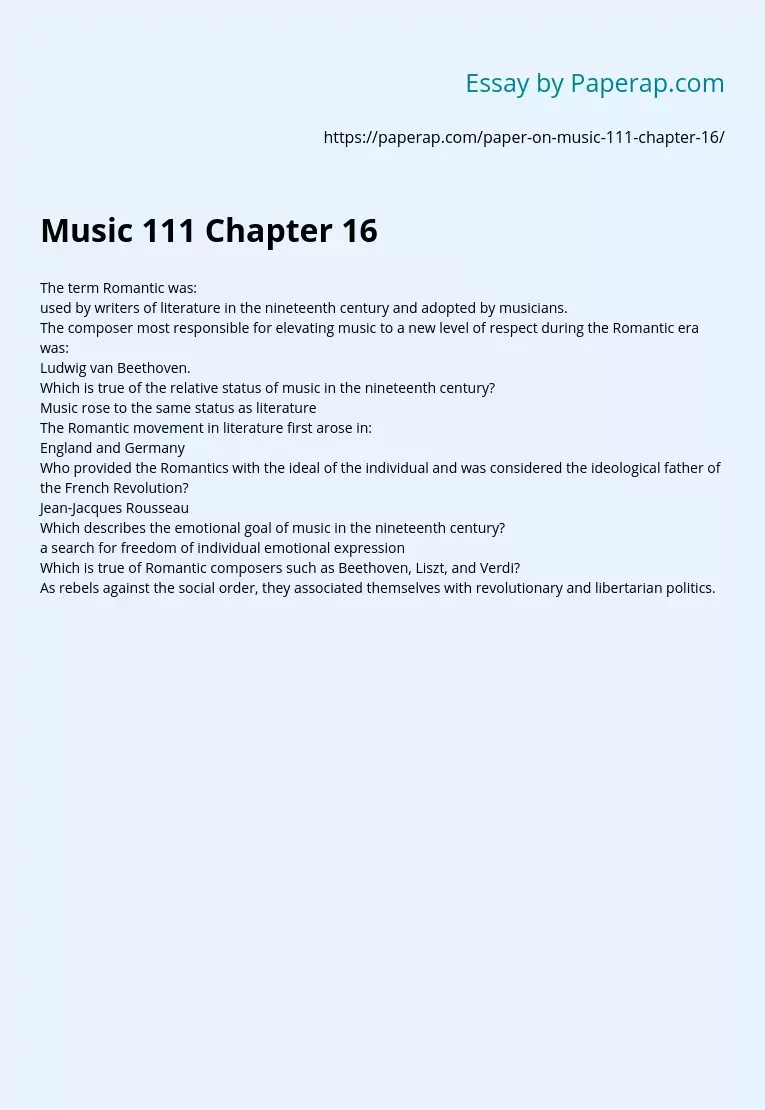Music 111 Chapter 16
Essay,
Pages 3 (574 words)
Views
77
The term Romantic was:
used by writers of literature in the nineteenth century and adopted by musicians.
The composer most responsible for elevating music to a new level of respect during the Romantic era was:
Ludwig van Beethoven.
Which is true of the relative status of music in the nineteenth century?
Music rose to the same status as literature
The Romantic movement in literature first arose in:
England and Germany
Who provided the Romantics with the ideal of the individual and was considered the ideological father of the French Revolution?
Jean-Jacques Rousseau
Which describes the emotional goal of music in the nineteenth century?
a search for freedom of individual emotional expression
Which is true of Romantic composers such as Beethoven, Liszt, and Verdi?
As rebels against the social order, they associated themselves with revolutionary and
libertarian politics.
libertarian politics.
Which is true of the social revolution of the nineteenth century?
Composers such as Liszt personally crossed class boundaries.
Which describes Romantic composers’ view of form and harmony?
Romantic composers did not allow form or genre to restrain spontaneous creativity.
An early monument to supernatural Romanticism was the opera The Magic Bullet by:
Carl Maria von Weber.
In the nineteenth century, which of the arts was believed to be the most capable of expressing inner experience and emotion?
music
Increasingly, the focal point for the performance of Romantic music was the:
concert hall.
What musical genres became established on the concert stage by the end of the nineteenth century?
lieder and string quartets
Which is true of the relationship between Romantic composers and the public?
Nineteenth-century audiences became more conservative and more critical of innovative composers.
The composer who started a music magazine to defend the music of the Romantics against public indifference was:
Robert Schumann.
The quality most prized by Romantic artists was:
the integrity of the expression of individual feeling
The musical term applied to flexibility in rhythm is:
rubato
Which statement is false?
Romantic melodies have more regular phrase lengths than Classical melodies.
Which statement is false?
Romantic harmonies were clearer and more diatonic, and they established a stronger sense of tonality than in earlier musical periods.
What is chromaticism?
using all twelve notes of the scale liberally
In which stylistic period was chromaticism used the most?
Romantic
Romantic treatment of tone color included:
combining and blending different instrumental tone colors in innovative ways.
Compared to the Classical orchestra, the typical Romantic orchestra was:
larger and blended tone colors in new ways
The important new member of the Romantic orchestra was the:
conductor.
In nineteenth-century opera, the orchestra:
increased in importance, sometimes providing special effects and overshadowing the voices.
Music without singing but derived from a poem, story, or other literary source, is called:
program music.
Romantic treatment of form was:
free and spontaneous
Miniatures were usually written for:
voice and piano or piano alone
Miniatures were generally heard:
as separate compositions.
Miniatures were given all of the following types of titles except:
formal titles such as sonata or rondo.
In composing a Romantic “grandiose” composition, composers created works with:
more movements and increased performing forces.
Thematic unity occurs:
when a composer uses the same themes in all movements of a work.
The technique of having the same theme fragment reappear with some sort of variation at loosely recurring intervals is:
thematic transformation.
All of the following are characteristic of thematic unity in Romantic symphonic music except:
using the same themes in several symphonies
Music 111 Chapter 16. (2018, Feb 01). Retrieved from https://paperap.com/paper-on-music-111-chapter-16/

